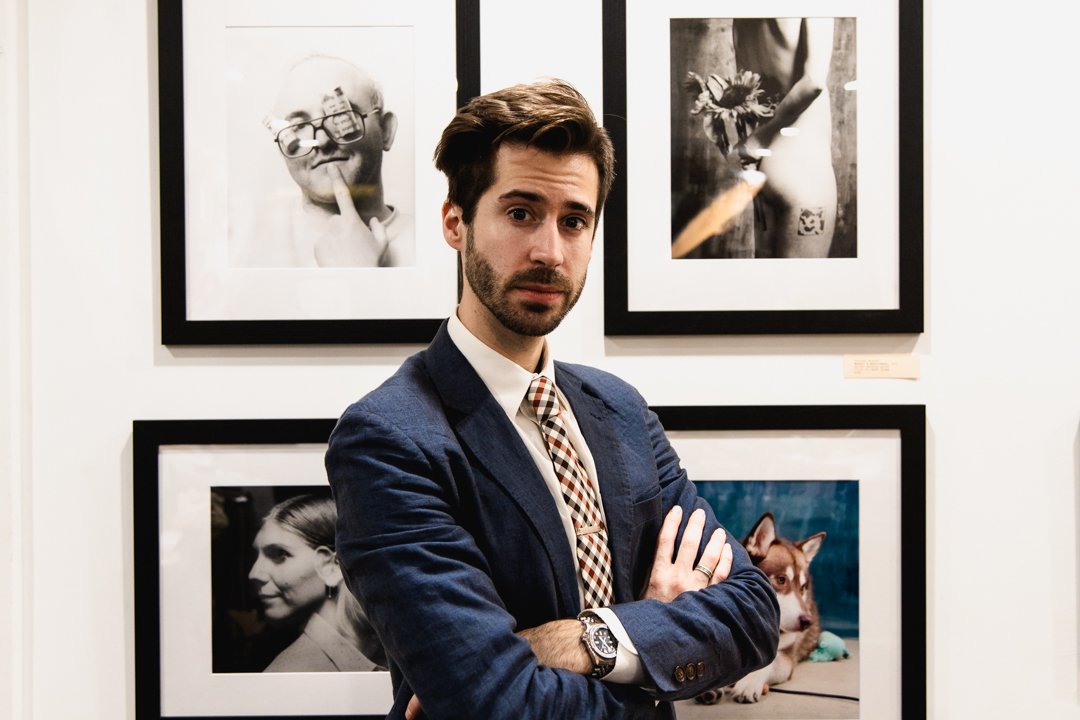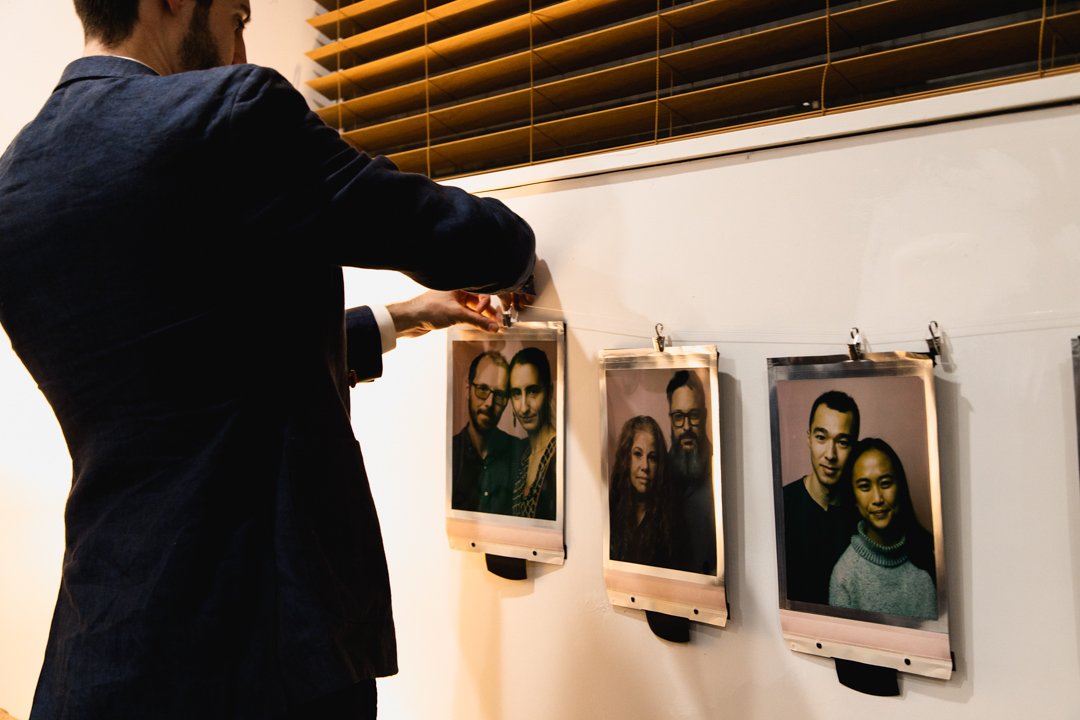Artist-In-Residence: Forrest Bourke
Meet Forrest, Assembly's January artist-in-residence. While his classic personal style is strongly reminiscent of early film photographers, the scenes and stories captured in his work are anything but traditional. He artfully captures humanized images from all aspects of life – from contorted nudes to proud pets. His compositions aren’t just aesthetically pleasing but effectively communicate a love for life and art.
We had the opportunity to interview Forrest for a behind-the-lense look into his life. So come along as we dive deeper into his world to explore how one man evokes emotions through film and what inspires him . . .
Forrest hails from Los Angeles. Yet, he must have heard the rumor that shadowy clouds and prevailing gloom create a more atmospheric appeal for a photograph (and, in our HUMBLE opinion, make for a more brooding artist persona) because he left that sun-drenched city for Seattle.
They say that adding colors of grey to an image amplifies its eeriness by a considerable degree. It also creates an irresistible wrinkle of mysteriousness in the narrative it attempts to craft. And while the gloomy color palette deepens the effect of the narrative itself, it acts as a faint reflection of grit and sadness amidst superfluous cheerfulness. In other words—it’s a different kind of beauty here.
Forrest has called Seattle home for over 5 years now, but it was just last month that he stumbled upon Assembly looking to catch Sara Leopold's art opening. “She’s a photographer whose work I’ve admired online, but we'd never met in person,” he says. “That opening was incredible.”
That night, he also met Molly and the Assembly team, igniting an idea for a show that was more interactive, something that could both educate and inspire those with shared interests.“We started chatting about having an opening with some of my work. Molly is incredibly vibrant, and the more we conversed, the more I got excited to open a show.”
The idea behind the show was simple; bring your camera and take portraits of individuals who share the same excitement as you do while introducing those unfamiliar with the form to something entirely new.
Forrest arrived with his 8 x 10 Calumet C1in hand (year unknown—I’m a writer, not a historian) keen to immortalize the many local photography fans in a series of portraits. Utilizing 8X10 integral film (this is the stuff) for the shoot, everyone's excitement was palpable as he explained the process step-by-step. The sheer rareness of each capture ignited the room in the moments between the flash of the camera and the outcome of the image.
All around him, fans of all ages were coaxed in raptures over what they were witnessing—true art being born in front of them! Okay, it wasn’t that dramatic, but it was very cool!
So how did Forrest get here? How did his upbringing shape his creativity? This a question many creative minds must spend time trying to answer. It is essential to gain an understanding of the origin behind their inborn need to express their ideas. What did their early life look and feel like that inculcated in them a drive for innovative expression? Did this happen slowly over time, or does it just come in flashes of spontaneous thought? Only through careful introspection can we truly grasp how much influence our upbringings can have on our soliloquies.
“I think my real intro to film photography was in college when someone posted "free film camera!" on an email list, and I was the lucky one who grabbed it first—a 35mm Pentax ME Super. I did a little digital photography in high school, but I never clicked with it. There's a lot of editing involved in doing good digital photography, which takes a lot of skill. It's just one skill that I don't have,” he says.
“I'm old enough to remember when film was the main photographic medium—I would bring disposable cameras on elementary school trips and then my family would get the photos developed at Costco.”
I think we can all agree that getting that envelope of photos back and sifting through them, smiling at the moments captured, was a highlight of that time.
“Photography is great because you can add it on to pretty much any other activity,” says Forrest. “I just default to bringing a camera everywhere, so I get pictures, to some extent, or whatever is in front of me,” says Forrest.
Photography can be more than just a form of art or an interesting pastime—it can also be reflective of our innermost selves. Many of us take photos to capture moments to remember, but photography can run even deeper than that. What we choose to photograph conveys our values and thoughts, elements that make up the backbone of our personality. One could say we are revealing something about ourselves by getting behind the lens and chronicling what we find important. Understanding this connection between personality and photographing could open up new windows into perceiving ourselves differently and appreciating other perspectives.
“Something I like to think about is how time can add value to a photo—a photo of “just hanging out” isn’t very special a week later, but a few years later, it becomes an artifact of a specific time and place and group of people. A really extended version of this is a photo from 70 years ago is made interesting purely by time, even if it’s just a mundane gas station or street scene.”
Inspiration can come from many places, but it’s often those who come before us with the same passions that help guide us in a particular direction. Taking the time to appreciate the work of other talented photographers can be an incredibly rewarding experience. We all know artists who have immensely inspiring stories and offer captivating visuals like no other. Someone whose attention to detail and creativity speaks to us. Some who are playfully surprising or methodical in their approach, and some are kind enough to give us a window into their perspective and understanding of their craft. So, out of all the talented photographers in his neck of the woods, who is Forrest’s favorite?
“I got to meet with Kurt Timmermeister last year and shoot at his farm's cheese cave/studio. He has such an incredible space and photographic style. He makes really consistent and beautifully analog portraits—I don’t even think he owns a scanner.”
As a part of the profession, it's a photographer's job to capture moments that mean something to someone—now, what the something is or who those someones are is up to the person behind the camera. A photographer's true artistry lies in their ability to freeze a moment of significance, whether breathtaking beauty or unflinching truth.
From tranquil scenes that warm hearts to war zones full of sorrow, the lens can capture emotion like no other. With every shot, they strive for perfection and document the world around them—no filter needed. So who are some of the other artists inspiring Forrest?
“I feel like I could go down a huge list, but Shelbie Dimond is a prolific ex-pat self-portrait artist on b&w film and Polaroids. I was actually going to meet up and shoot with her over the summer on one of her US visits, but I got (a mild case of) COVID, so it never ended up happening,” he says.
“I’ve also been penpals with German photographer Kim Schwanhaeusser for several years—we mail each other prints and letters back and forth. She’s a darkroom master and spends a lot of time on her compositions; she does lovely work, especially with flowers. I love having folks from whom I can draw inspiration, and I’m lucky to have some of Kim’s prints so I can see them without flying to Germany.”
Like those who inspire him, when it comes to creating something special, Forrest likes to think outside the box, mining his imagination and following wherever it may lead. “I really fell in love with film photography because it combines the technical and tactile elements that I enjoy with the artistic process. I get a lot of gratification making things with my hands, but I've never felt that I have control over the medium in things like drawing or painting,” he says.
“I've heard the marriage of technical and artistic elements called "craft," and I think that element of film photography is really what appealed to me in the beginning and has also kept me interested for so many years—there's always more to learn.”
So, what will Forrest be sipping on while mulling over his next shoot—should you encounter him some fateful day at Assembly? I'm here to tell you that he doesn't drink coffee; after all, what's the risk in telling you this (disturbing) revelation so long after he’s completed his opening?
“To clarify, if you find me sipping on anything caffeinated, it would usually be a matcha latte or a London fog. Both of these drinks are deliciously soothing ways for me to satisfy my caffeine cravings without having to stick straight to traditional coffees.”
Well….
You can enjoy Forrest Bourke's work through the month of January at Assembly. Can't make it, or simply want to see more from this artist? Follow him on Instagram @forrest.bourke
If you enjoyed this article, check out Artist-In-Residence: Shogo Ota










